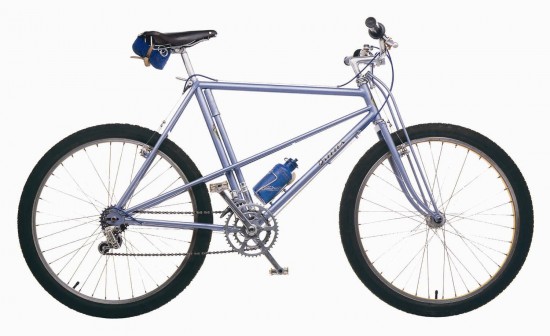Bicycle Kick (11)
By:
May 28, 2010

Above, the Breezer Series I, arguably the first production mountain bike. Designed by Joe Breeze (b. 1953), who with friend and rival Gary Fisher (b. 1950) and a tight-knit group of Boomers in the hills north of San Francisco pioneered what would become the dominant consumer form bicycles would take for the next thirty years. Breeze and Fisher began building bikes to withstand the rigors of downhill riding; the millions of chunky, fat-tire bicycles in garages today are the grandchildren of those early handbuilt frames.
Breeze’s bike, which appeared in 1978, differs from a latter-day mountain bikes in ways obvious to even the most casual viewer. In particular note the long, angled stays running from head tube to rear axles. Bracing of this sort had appeared in French unisex or “mixte” bicycles in the first part of the twentieth century. Breeze would later drop the bracing to save weight — but not before Raleigh aped the design in their first mass-produced mountain bikes. Aficionados will also observe the Brooks saddle and track dropouts that have become de rigeur in the messenger bike movement, a Revivalist-generation phenomenon whose DIY ethos is partially a rejoinder to the commodification of cycling that took place in Breeze and Fisher’s wake. It’s worth noting that like the latter-day messenger bikes, Fisher and Breeze’s rides began as repurposing of older forms: spirited machines, ingenious remixes, cobbled together of spare parts and self-taught craftsmanship — a far cry from the racks of mass-produced mountain bikes on sale at Wal-Mart today.
Breeze and Fisher are two examples one of their generation’s signal cohorts: the hippie entrepreneurs. From endless weekends spent smoking pot and bombing downhill, these bewhiskered party animals went on to found major bicycle manufacturing companies (Breezer is independently owned; Gary Fisher is a subsidiary of Trek). Following the lead of Yvon Chouinard (b. 1938), a Quebec-born (check) blacksmith and rock climber whose business selling pitons out of the trunk of his car became Patagonia, one of the world’s most successful outdoor lifestyle brands; and like Jake Burton Carpenter (b. 1954), who added bindings to the backyard “Snurfer” snow toys of the 1960s, creating the modern snowboard; they helped to transform a marginalized activity into a major normative lifestyle choice — one with vast array of specialized apparel and accoutrements. Today, you can feel pretty good about heading to the coffeeshop on your Breezer or Gary Fisher bicycle while wearing your Patagonia long-sleeve jersey woven from reclaimed coconut fibers. If it’s chilly, throw on your Burton logo hoodie — the one with the lift ticket from Sugarloaf still dangling from it — and affect a leisure-class, luxe snowsport cool tempered with skate-punk insouciance. The lifestyle tycoons began as spirited hedonists, and ended up helping to turning virtue into a commodity.
Eleventh in a series of twelve.
